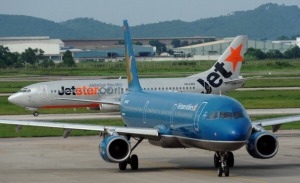 Bad debt and bad bankers have dominated most headlines about Việt Nam in the last few years.
Bad debt and bad bankers have dominated most headlines about Việt Nam in the last few years.
What gets less attention, however, is its promising tourist industry.
Unfortunately, getting people to Việt Nam’s tourist attractions has nevertheless proved difficult.
The country’s airlines are struggling to stay alive, let alone profitable.
Of the five private airlines launched in Việt Nam since 2007, only one is still in business.
Air Mekong, funded by property and food investor BIM Group, was crippled by fuel debts and suspended services in February.
Trai Thien Air Cargo ceased operation due to escalating costs, as did Indochina Airlines, which was owned by a music composer.
Local media reports that small-scale local carrier Blue Sky Air was planning a charter service but the scheme never gained momentum.
Start-ups suffered intense competition from the state-subsidised carrier Việt Nam Airlines, high fuel costs, a shortage of local pilots and low margins.
The problem of mollycoddled state-owned companies crowding out much needed private enterprise is being felt right across the Vietnamese economy.
Surprisingly however, the survivor, budget carrier VietJet Air, only began flying at the end of 2011 but is already Việt Nam’s second largest operator, with about a 15 per cent market share.
Việt Nam Airlines dominates the sector with about 70 per cent of the market.
At the end of 2015 Việt Nam will be one of 10 regional peers founding the Association of Southeast Asian Nations Economic Community, a free trade agreement which, among other things, allows greater competition between regional airlines and wider access to airports under the Asean Single Aviation Market, part of a broader “Open Sky Policy.”
Neil Dave, an analyst at the business consultant Frost & Sullivan, recently told international media that consumers will benefit “from increased choice of destinations, routes and greater affordability with rising standards of living and cost-savings passed down from airlines.”
But he also warned that in some countries, small and developing aviation industries, even when state-subsidised, may face stiff competition from regional rivals which could squeeze them out of the market.
Việt Nam Airlines may stay in the game, but it is unclear how prepared the company is for regional integration.
Information about the operator is opaque.
Local media reports that in 2012 its revenue reached $2.4bn, up 6.3 per cent on the year before.
Profits were $3.3m, up a remarkable 239 per cent on 2011, but only 20 per cent of the company’s original target for 2012.
The airline has a planned initial public offering this year of 25 to 35 per cent of the company as part of a restructuring plan that will finish in 2015.
As well as the planned partial sell-off, which the government hopes will raise around $200m, Việt Nam Airlines will be subjected to the same kind of streamlining seen elsewhere inViệt Nam’s massive state-owned enterprises.
The airline said in 2011, not for the first time, that it was planning an IPO, but details have changed, including the proposed date, and no offering has yet come to fruition.
If the government wants its flag carrier to remain competitive in the face of regional giants like Air Asia, it would be wise to complete the restructuring process as soon as possible.
The good news for Việt Nam’s airlines is that tourism is strong and growing, even if at a slower rate than the industry would like.
Việt Nam welcomed 6.8m visitors in 2012, of which 5.5m arrived by air.
Two-thirds were tourists, according to official statistics, and total international arrivals were up 14 per cent on 2011.
Việt Nam can offer beaches and warm waters to rival Thailand.
The question is whether it will be national or regional airlines bringing in people to enjoy them.
Source: FT